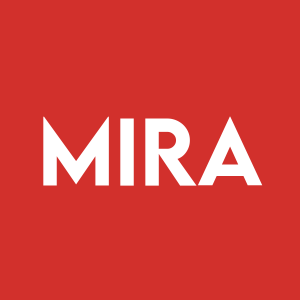MIRA Reports Clear Reversal of Anxiety-Related Behavior in Animal Model Using SKNY-1, an Oral Drug Candidate for Obesity and Nicotine Addiction Under Definitive Agreement for Acquisition
Rhea-AI Summary
MIRA Pharmaceuticals (NASDAQ:MIRA) announced promising new preclinical results for SKNY-1, their oral drug candidate for obesity and nicotine addiction. The drug demonstrated clear reversal of anxiety-related behavior in animal models, while maintaining its previously shown benefits of up to 30% weight loss and craving reduction.
SKNY-1, which is currently under a definitive acquisition agreement, targets the Cannabinoid 1 receptor (CB1) without the serious central nervous system side effects that led to the discontinuation of earlier CB1-targeting drugs. The compound has shown ability to reverse high-calorie food and nicotine cravings while preserving muscle mass in preclinical studies.
Positive
- Drug candidate SKNY-1 achieved significant 30% weight loss in preclinical models
- Demonstrated clear reversal of anxiety-related behavior, unlike previous CB1-targeting drugs
- Shows potential for treating both obesity and nicotine addiction markets
- Maintains muscle mass while reducing food and nicotine cravings
- Drug is under definitive acquisition agreement, indicating business development progress
Negative
- Results are only from preclinical animal studies, not yet tested in humans
- Timeline for human clinical trials not specified
- Acquisition agreement details and terms not disclosed
SKNY-1 was previously shown to achieve up to
MIAMI, FL / ACCESS Newswire / July 11, 2025 / MIRA Pharmaceuticals, Inc. (NASDAQ:MIRA) today announced new preclinical results from SKNY-1, an oral drug candidate for obesity and nicotine addiction currently under definitive agreement for acquisition. In a validated behavioral model used to measure Cannabinoid 1 receptor (CB1) related anxiety-like effects, SKNY-1 demonstrated clear reversal of anxiety-related behavior induced by a CB1 activator, setting it apart from earlier CB1-targeting drugs that were discontinued due to serious central nervous system (CNS) effects.
SKNY-1 is being developed as a potential oral treatment for obesity and addiction. It has previously been shown to achieve up to
"These findings are a significant step forward," said Erez Aminov, Chief Executive Officer of MIRA. "The ability to suppress appetite and cravings while reversing anxiety-like effects is critical. These results reinforce the differentiated approach behind SKNY-1 and its potential role as a novel oral treatment in large, underserved markets."
About the Study
The study used the light-dark preference test in zebrafish-a validated behavioral model to assess anxiety-related responses. Zebrafish naturally prefer darker environments due to an innate fear of predators. However, when anxiety levels are elevated, they avoid the light even more strongly spending more time in the dark. Reduced dark preference (i.e., more time in the light) is interpreted as a calming effect.
Four groups were evaluated:
Control Group (No Drug): Fish showed balanced behavior between light and dark environments.
CP55,940 Group (CB1 Agonist): These animals spent significantly more time in the dark, confirming that CB1 activation increases anxiety at higher doses. Interestingly, at lower doses, CP55,940 produced a calming effect-reducing dark preference and encouraging exploration of the light area.
Rimonabant Group (CB1 Inverse Agonist): Fish treated with Rimonabant also showed increased dark-zone time and exhibited a greater increase in anxiety-like behavior than the CB1 agonist group, under both high and low doses of agonist-consistent with the known psychiatric effects that led to Rimonabant's market withdrawal.
SKNY-1 Groups: In animals co-treated with CP55,940, SKNY-1 significantly reversed the anxiety-inducing effects of high-dose CP55,940 and enhanced the calming effects at low doses. In all conditions, SKNY-1 brought anxiety-like behavior back to control or better-than-control levels.
These results suggest SKNY-1 may help stabilize mood and stress-related behavior-a potential advantage in treating both metabolic and addictive disorders.
A New Approach to Endocannabinoid Modulation
SKNY-1 targets the endocannabinoid system (ECS)-a key regulator of hunger, emotion, reward, and addictive behavior-through a multi-pathway approach:
Biased CB1 antagonism blocks β-arrestin signaling (linked to cravings and compulsive behavior) while preserving G-protein signaling (important for emotional regulation).
CB2 partial agonism may reduce inflammation in the brain, which is increasingly recognized as a driver of anxiety, depression, and cognitive decline. By lowering neuroinflammation, SKNY-1 may help preserve emotional balance and support cognitive resilience.
Mild inhibition of MAO-B regulates dopamine, which plays a role in motivation and behavioral control.
No inhibition of MAO-A confirmed through in vitro screening-important because MAO-A inhibitors are associated with mood instability, drug interactions, and safety concerns.
This multi-target profile gives SKNY-1 a differentiated mechanism that may allow it to reduce cravings and weight while supporting emotional health-without the psychiatric side effects that limited earlier CB1 or MAO-based drugs.
"The ability to block cravings while preserving emotional balance is a key challenge in this field," said Dr. Itzchak Angel, MIRA's Chief Scientific Advisor. "SKNY-1 appears to meet that challenge head-on. The demonstration that its profile is significantly different than rimonabant in its interaction with CB1 agonists, reinforces the unique pharmacological profile of the drug."
Market Opportunity
Obesity and addiction are among the most urgent and expensive public health challenges globally. In the U.S. alone, the economic burden of obesity and related chronic diseases is estimated at
Current GLP‑1 therapies like semaglutide deliver weight loss but are injectables, often cause gastrointestinal side effects, and can result in loss of lean muscle mass. Smoking cessation therapies such as varenicline or bupropion offer modest long-term success and may carry psychiatric warnings that restrict their use in sensitive patient populations. Earlier CB1-targeting drugs, including rimonabant, were withdrawn due to severe mood disorders. Furthermore, broad MAO inhibition-especially MAO‑A-has long been associated with mood instability and dangerous food-drug interactions.
SKNY‑1 was developed to address those limitations directly. With oral administration, differentiated pharmacology, and potential dual efficacy in obesity and nicotine addiction, SKNY‑1 may offer a best-in-class profile. Its lack of MAO‑A inhibition, confirmed in vitro, further enhances its therapeutic promise.
Next Steps
MIRA is currently preparing for shareholder approval related to the proposed acquisition of SKNY Pharmaceuticals, Inc. Pending approval, the Company expects to initiate Investigational New Drug (IND)-enabling studies for SKNY-1 as a next step toward human clinical trials.
About MIRA Pharmaceuticals, Inc.
MIRA Pharmaceuticals, Inc. (NASDAQ:MIRA) is a clinical-stage pharmaceutical company focused on the development and commercialization of novel therapeutics for neurologic, neuropsychiatric, and metabolic disorders. The Company's pipeline includes oral drug candidates designed to address significant unmet medical needs in areas such as neuropathic pain, inflammatory pain, obesity, addiction, anxiety, and cognitive decline.
Cautionary Note Regarding Forward-Looking Statements
This press release and the statements of MIRA's management related thereto contain "forward-looking statements," which are statements other than historical facts made pursuant to the safe harbor provisions of Section 27A of the Securities Act of 1933, as amended, and Section 21E of the Securities Exchange Act of 1934, as amended. These statements may be identified by words such as "aims," "anticipates," "believes," "could," "estimates," "expects," "forecasts," "goal," "intends," "may," "plans," "possible," "potential," "seeks," "will," and variations of these words or similar expressions that are intended to identify forward-looking statements. Any statements in this press release that are not historical facts may be deemed forward-looking. Any forward-looking statements in this press release are based on MIRA's current expectations, estimates, and projections only as of the date of this release and are subject to a number of risks and uncertainties (many of which are beyond MIRA's control) that could cause actual results to differ materially and adversely from those set forth in or implied by such forward-looking statements, including related to MIRA's potential merger with SKNY Pharmaceuticals, Inc. These and other risks concerning MIRA's programs and operations are described in additional detail in the Annual Report on Form 10-K for the year ended December 31, 2024, and the Form 14A filed by MIRA on June 18, 2025, and other SEC filings, which are on file with the SEC at www.sec.gov and on MIRA's website at https://www.mirapharmaceuticals.com/investors/sec-filings. MIRA explicitly disclaims any obligation to update any forward-looking statements except to the extent required by law.
Contact:
Helga Moya
info@mirapharma.com
(786) 432-9792
SOURCE: MIRA Pharmaceuticals
View the original press release on ACCESS Newswire









